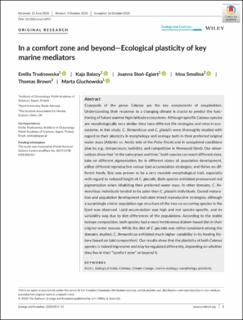In a comfort zone and beyond—Ecological plasticity of key marine mediators
Trudnowska, Emilia; Ostaszewska, Kaja; Stoń-Egiert, Joanna; Smolina, Irina Vladimirovna; Brown, Thomas; Gluchowska, Marta
Peer reviewed, Journal article
Published version

View/
Date
2020Metadata
Show full item recordCollections
Original version
Trudnowska, E., Balazy, K., Ston-Egiert, J., Smolina, I., Brown, T. & Gluchowska, M. (2020). In a comfort zone and beyond—Ecological plasticity of key marine mediators. Ecology and Evolution, 10(24), 14067-14081. doi: 10.1002/ece3.6997Abstract
Copepods of the genus Calanus are the key components of zooplankton. Understanding their response to a changing climate is crucial to predict the functioning of future warmer high‐latitude ecosystems. Although specific Calanus species are morphologically very similar, they have different life strategies and roles in ecosystems. In this study, C. finmarchicus and C. glacialis were thoroughly studied with regard to their plasticity in morphology and ecology both in their preferred original water mass (Atlantic vs. Arctic side of the Polar Front) and in suboptimal conditions (due to, e.g., temperature, turbidity, and competition in Hornsund fjord). Our observations show that “at the same place and time,” both species can reach different sizes, take on different pigmentation, be in different states of population development, utilize different reproductive versus lipid accumulation strategies, and thrive on different foods. Size was proven to be a very mutable morphological trait, especially with regard to reduced length of C. glacialis. Both species exhibited pronounced red pigmentation when inhabiting their preferred water mass. In other domains, C. finmarchicus individuals tended to be paler than C. glacialis individuals. Gonad maturation and population development indicated mixed reproductive strategies, although a surprisingly similar population age structure of the two co‐occurring species in the fjord was observed. Lipid accumulation was high and not species‐specific, and its variability was due to diet differences of the populations. According to the stable isotope composition, both species had a more herbivorous diatom‐based diet in their original water masses. While the diet of C. glacialis was rather consistent among the domains studied, C. finmarchicus exhibited much higher variability in its feeding history (based on lipid composition). Our results show that the plasticity of both Calanus species is indeed impressive and may be regulated differently, depending on whether they live in their “comfort zone” or beyond it.
